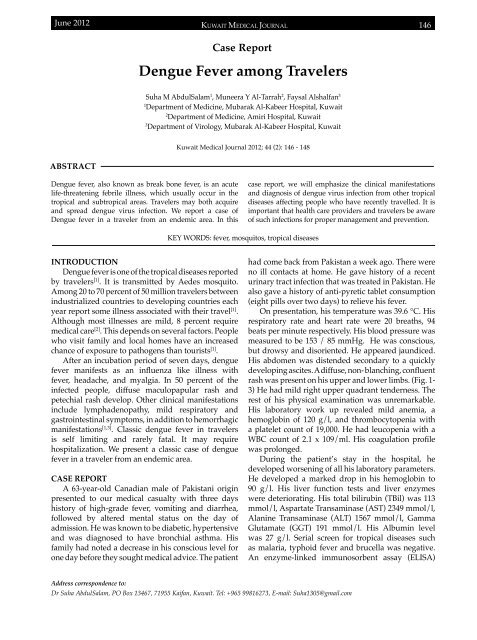Vol 44 # 2 June 2012 - Kma.org.kw
Vol 44 # 2 June 2012 - Kma.org.kw
Vol 44 # 2 June 2012 - Kma.org.kw
Create successful ePaper yourself
Turn your PDF publications into a flip-book with our unique Google optimized e-Paper software.
<strong>June</strong> <strong>2012</strong><br />
KUWAIT MEDICAL JOURNAL 146<br />
Case Report<br />
Dengue Fever among Travelers<br />
Suha M AbdulSalam 1 , Muneera Y Al-Tarrah 2 , Faysal Alshalfan 3<br />
1<br />
Department of Medicine, Mubarak Al-Kabeer Hospital, Kuwait<br />
2<br />
Department of Medicine, Amiri Hospital, Kuwait<br />
3<br />
Department of Virology, Mubarak Al-Kabeer Hospital, Kuwait<br />
Kuwait Medical Journal <strong>2012</strong>; <strong>44</strong> (2): 146 - 148<br />
ABSTRACT<br />
Dengue fever, also known as break bone fever, is an acute<br />
life-threatening febrile illness, which usually occur in the<br />
tropical and subtropical areas. Travelers may both acquire<br />
and spread dengue virus infection. We report a case of<br />
Dengue fever in a traveler from an endemic area. In this<br />
case report, we will emphasize the clinical manifestations<br />
and diagnosis of dengue virus infection from other tropical<br />
diseases affecting people who have recently travelled. It is<br />
important that health care providers and travelers be aware<br />
of such infections for proper management and prevention.<br />
KEY WORDS: fever, mosquitos, tropical diseases<br />
INTRODUCTION<br />
Dengue fever is one of the tropical diseases reported<br />
by travelers [1] . It is transmitted by Aedes mosquito.<br />
Among 20 to 70 percent of 50 million travelers between<br />
industrialized countries to developing countries each<br />
year report some illness associated with their travel [1] .<br />
Although most illnesses are mild, 8 percent require<br />
medical care [2] . This depends on several factors. People<br />
who visit family and local homes have an increased<br />
chance of exposure to pathogens than tourists [1] .<br />
After an incubation period of seven days, dengue<br />
fever manifests as an influenza like illness with<br />
fever, headache, and myalgia. In 50 percent of the<br />
infected people, diffuse maculopapular rash and<br />
petechial rash develop. Other clinical manifestations<br />
include lymphadenopathy, mild respiratory and<br />
gastrointestinal symptoms, in addition to hemorrhagic<br />
manifestations [1,3] . Classic dengue fever in travelers<br />
is self limiting and rarely fatal. It may require<br />
hospitalization. We present a classic case of dengue<br />
fever in a traveler from an endemic area.<br />
CASE REPORT<br />
A 63-year-old Canadian male of Pakistani origin<br />
presented to our medical casualty with three days<br />
history of high-grade fever, vomiting and diarrhea,<br />
followed by altered mental status on the day of<br />
admission. He was known to be diabetic, hypertensive<br />
and was diagnosed to have bronchial asthma. His<br />
family had noted a decrease in his conscious level for<br />
one day before they sought medical advice. The patient<br />
had come back from Pakistan a week ago. There were<br />
no ill contacts at home. He gave history of a recent<br />
urinary tract infection that was treated in Pakistan. He<br />
also gave a history of anti-pyretic tablet consumption<br />
(eight pills over two days) to relieve his fever.<br />
On presentation, his temperature was 39.6 °C. His<br />
respiratory rate and heart rate were 20 breaths, 94<br />
beats per minute respectively. His blood pressure was<br />
measured to be 153 / 85 mmHg. He was conscious,<br />
but drowsy and disoriented. He appeared jaundiced.<br />
His abdomen was distended secondary to a quickly<br />
developing ascites. A diffuse, non- blanching, confluent<br />
rash was present on his upper and lower limbs. (Fig. 1-<br />
3) He had mild right upper quadrant tenderness. The<br />
rest of his physical examination was unremarkable.<br />
His laboratory work up revealed mild anemia, a<br />
hemoglobin of 120 g/l, and thrombocytopenia with<br />
a platelet count of 19,000. He had leucopenia with a<br />
WBC count of 2.1 x 109/ml. His coagulation profile<br />
was prolonged.<br />
During the patient’s stay in the hospital, he<br />
developed worsening of all his laboratory parameters.<br />
He developed a marked drop in his hemoglobin to<br />
90 g/l. His liver function tests and liver enzymes<br />
were deteriorating. His total bilirubin (TBil) was 113<br />
mmol/l, Aspartate Transaminase (AST) 2349 mmol/l,<br />
Alanine Transaminase (ALT) 1567 mmol/l, Gamma<br />
Glutamate (GGT) 191 mmol/l. His Albumin level<br />
was 27 g/l. Serial screen for tropical diseases such<br />
as malaria, typhoid fever and brucella was negative.<br />
An enzyme-linked immunosorbent assay (ELISA)<br />
Address correspondence to:<br />
Dr Suha AbdulSalam, PO Box 13467, 71955 Kaifan, Kuwait. Tel: +965 99816273, E-mail: Suha1305@gmail.com
















